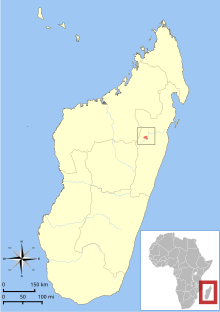Lac Alaotra bamboo lemur: Difference between revisions
m r2.7.3) (Robot: Adding vi:Hapalemur alaotrensis |
+reference |
||
| Line 19: | Line 19: | ||
}} |
}} |
||
The '''Lac Alaotra bamboo lemur''' ('''''Hapalemur alaotrensis'''''), also known as the '''Lac Alaotra gentle lemur''', '''Alaotran bamboo lemur''', '''Alaotran gentle lemur''', or locally as the ''{{lang|mg|bandro}}'', is a [[bamboo lemur]]. It is endemic to the reed beds in and around [[Lac Alaotra]], in northeast [[Madagascar]]. This lemur is the only primate specifically adapted to living in [[papyrus]] reeds. Unlike other bamboo lemurs, the Lac Alaotra bamboo lemur does not eat bamboo; instead, it feeds on the papyrus reeds of |
The '''Lac Alaotra bamboo lemur''' ('''''Hapalemur alaotrensis'''''), also known as the '''Lac Alaotra gentle lemur''', '''Alaotran bamboo lemur''', '''Alaotran gentle lemur''', or locally as the ''{{lang|mg|bandro}}'', is a [[bamboo lemur]]. It is endemic to the reed beds in and around [[Lac Alaotra]], in northeast [[Madagascar]]. This lemur is the only primate specifically adapted to living in [[papyrus]] reeds. Unlike other bamboo lemurs, the Lac Alaotra bamboo lemur does not eat bamboo; instead, it feeds on the stems of papyrus reeds, shoots of ''[[Phragmites communis]]'', and two types of grasses (''[[Echinocochla crusgalli]]'' and ''[[Leersia hexandra]]'').<ref name="Mutschler1999">{{Cite doi|10.1007/978-1-4615-4705-1_13}}</ref> |
||
Its tail and body are both 40 cm on average, and it weighs between 1.1 and 1.4 kg, with males slightly larger than females.<ref name=CI>{{cite book | author = Mittermeier, Russell A., Konstant, William R., Hawkins, Frank , Louis, Edward E., and Langrand, Olivier | year = 2006 | title = Lemurs of Madagascar | publisher = Conservation International | edition = 2nd edition | url = http://www.madagascar-library.com/r/544.html | accessdate = 2006-10-29 | pages = 222–225}}</ref> Its dense, woolly fur is a gray-brown on the back, lighter gray on the face and chest, and chestnut brown on the head and neck.<ref name=CI/> |
Its tail and body are both 40 cm on average, and it weighs between 1.1 and 1.4 kg, with males slightly larger than females.<ref name=CI>{{cite book | author = Mittermeier, Russell A., Konstant, William R., Hawkins, Frank , Louis, Edward E., and Langrand, Olivier | year = 2006 | title = Lemurs of Madagascar | publisher = Conservation International | edition = 2nd edition | url = http://www.madagascar-library.com/r/544.html | accessdate = 2006-10-29 | pages = 222–225}}</ref> Its dense, woolly fur is a gray-brown on the back, lighter gray on the face and chest, and chestnut brown on the head and neck.<ref name=CI/> |
||
Revision as of 14:03, 23 January 2013
| Lac Alaotra bamboo lemur[1] | |
|---|---|

| |
| Scientific classification | |
| Kingdom: | |
| Phylum: | |
| Class: | |
| Order: | |
| Family: | |
| Genus: | |
| Species: | H. alaotrensis
|
| Binomial name | |
| Hapalemur alaotrensis (Rumpler, 1975)
| |

| |
| Lac Alaotra bamboo lemur range | |
The Lac Alaotra bamboo lemur (Hapalemur alaotrensis), also known as the Lac Alaotra gentle lemur, Alaotran bamboo lemur, Alaotran gentle lemur, or locally as the bandro, is a bamboo lemur. It is endemic to the reed beds in and around Lac Alaotra, in northeast Madagascar. This lemur is the only primate specifically adapted to living in papyrus reeds. Unlike other bamboo lemurs, the Lac Alaotra bamboo lemur does not eat bamboo; instead, it feeds on the stems of papyrus reeds, shoots of Phragmites communis, and two types of grasses (Echinocochla crusgalli and Leersia hexandra).[3]
Its tail and body are both 40 cm on average, and it weighs between 1.1 and 1.4 kg, with males slightly larger than females.[4] Its dense, woolly fur is a gray-brown on the back, lighter gray on the face and chest, and chestnut brown on the head and neck.[4]
The classification of the bandro is disputed, with some classifying it as a subspecies of Hapalemur griseus,[2] while others see it as a separate species.[1] Current genetic data do not support species status.[5] Mitochondrial DNA sequences from the two populations H. g. griseus and H. g. alaotrensis are interspersed with each other on the phylogenetic tree.[6] Moreover, average genetic distances between the two subspecies are within the range of within-taxon comparisons and not in the range of between-taxon comparisons. A final assessment of species versus subspecies status requires filling in gaps in sampling and the use of nuclear loci. GenBank, the universal repository for genetic sequence information, has not accepted the species status of the Aloatran lemur and lists it as a subspecies.[7]
The Durrell Wildlife Conservation Trust has a Lac Alaotra bamboo lemur conservation program.
References
- ^ a b Groves, C. P. (2005). Wilson, D. E.; Reeder, D. M. (eds.). Mammal Species of the World: A Taxonomic and Geographic Reference (3rd ed.). Baltimore: Johns Hopkins University Press. p. 116. ISBN 0-801-88221-4. OCLC 62265494.
- ^ a b Template:IUCN2008
- ^ Attention: This template ({{cite doi}}) is deprecated. To cite the publication identified by doi:10.1007/978-1-4615-4705-1_13, please use {{cite journal}} (if it was published in a bona fide academic journal, otherwise {{cite report}} with
|doi=10.1007/978-1-4615-4705-1_13instead. - ^ a b Mittermeier, Russell A., Konstant, William R., Hawkins, Frank , Louis, Edward E., and Langrand, Olivier (2006). Lemurs of Madagascar (2nd edition ed.). Conservation International. pp. 222–225. Retrieved 2006-10-29.
{{cite book}}:|edition=has extra text (help)CS1 maint: multiple names: authors list (link) - ^ Pastorini, J., Forstner, M. R. J. and Martin, R. D. 2002. Phylogenetic relationships of gentle lemurs (Hapalemur). Evolutionary Anthropology 11, 150-154.
- ^ Figure 1 of Pastorini, J., Forstner, M. R. J. and Martin, R. D. 2002. Phylogenetic relationships of gentle lemurs (Hapalemur). Evolutionary Anthropology 11, 150-154
- ^ NCBI taxonomy database: http://www.ncbi.nlm.nih.gov/Taxonomy/Browser/wwwtax.cgi

